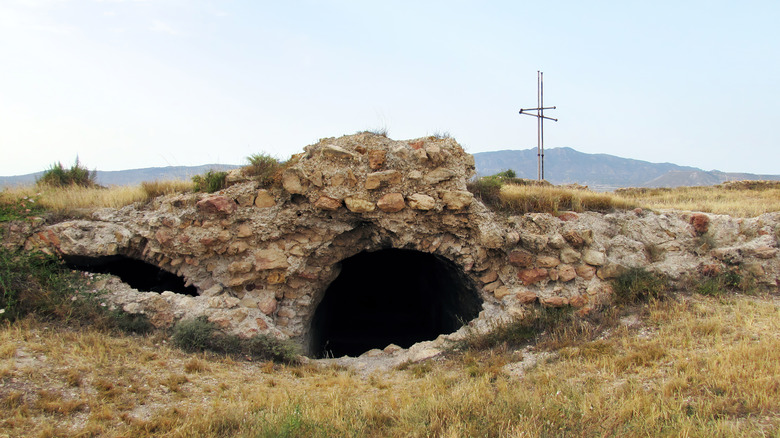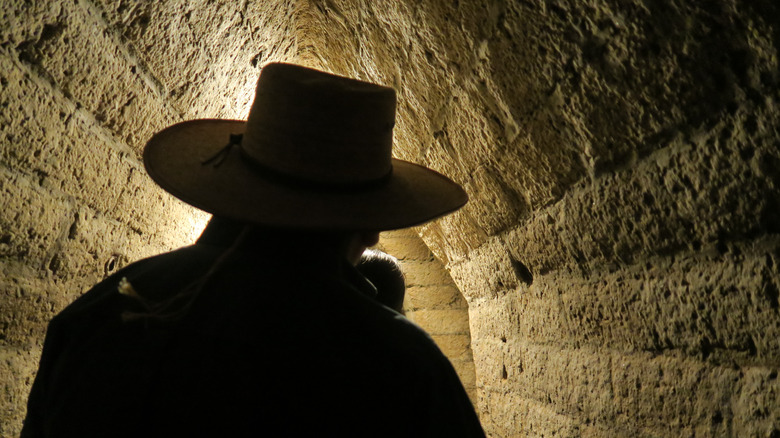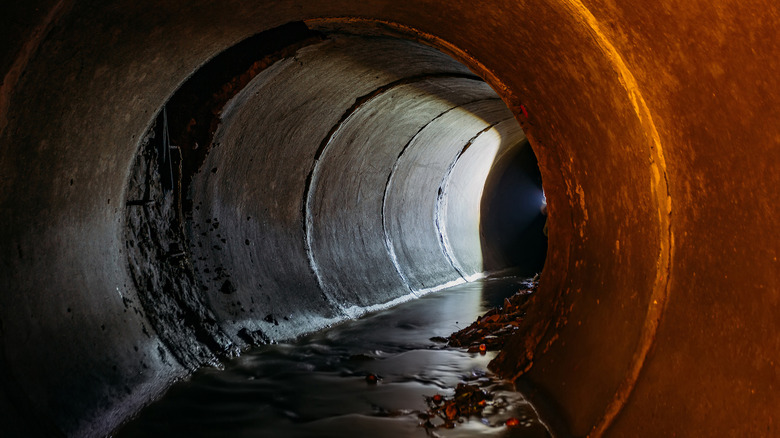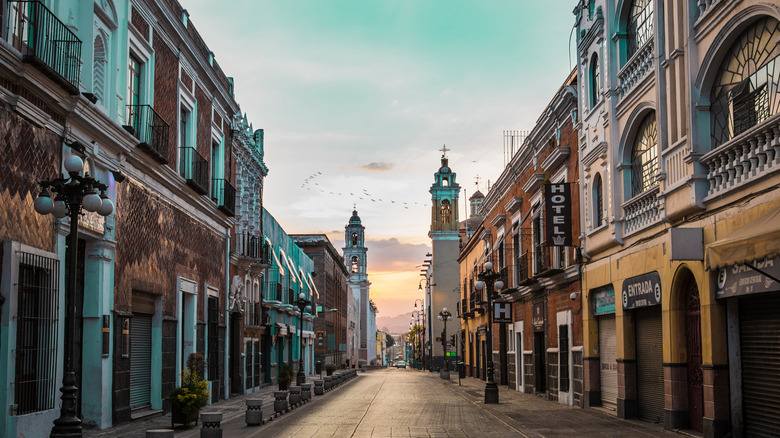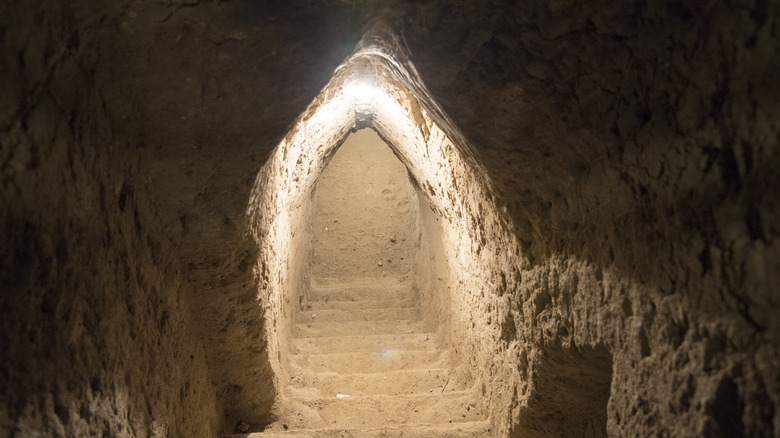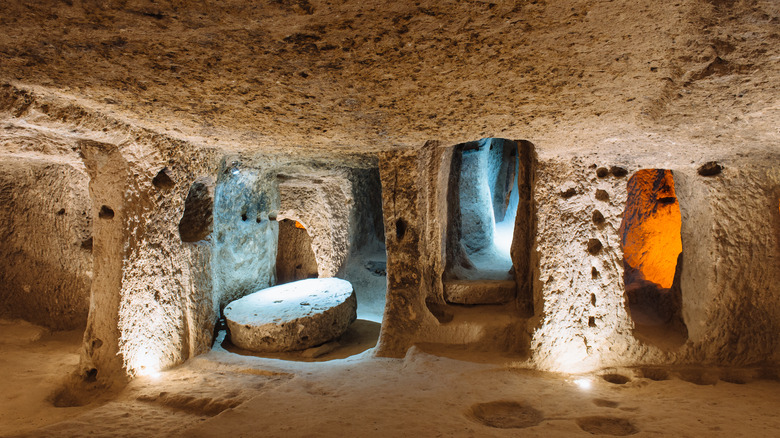How The Urban Legend Of The Puebla Tunnels Was Proven True
How often is it that an urban legend proves to be true? That's just what happened in Puebla, Mexico, when a series of tunnels was discovered under the city. Previously thought to be the stuff of myth, the tunnels had been mentioned in folklore passed down from generation to generation, according to Atlas Obscura. In the tales, the tunnels were used by royalty in the inquisition, or else proved to be useful during the revolution.
When the tunnels were uncovered in 2016, it was a shock for archeologists and novices alike. Revealed by public works employees, the discovery of the tunnels didn't just intrigue readers — it offered potential insight into many different periods in Puebla history, according to Mexico News Daily. Since the system's discovery in 2016, it has been investigated closely by historians who seek clues about how the existence of these tunnels could explain events in Puebla's history, including the 1862 defeat of the French army by a Mexican militia, according to Puebla City. The tunnels have also been turned into a museum and opened up to the public so people can learn more about what the system looked like, who created it, and how it came to be hidden for so many years.
What the Puebla tunnel system looks like
The tunnels themselves are about 23 feet high and 11.5 feet wide and are created out of stone, according to Mexico News Daily. Most experts date the tunnels between the 1500s and 1800s, with many estimating that the tunnel systems were expanded and built slowly over the centuries, according to Al Jazeera.
It wasn't long after the Puebla tunnel system was discovered before historians and archaeologists realized how large it was. Some estimates say there may be more than 6 miles of tunnels, though the entire tunnel system has not yet been comprehensively explored. Instead, archeologists have worked slowly to excavate the tunnels piece by piece while keeping their exact location a secret to avoid any potential damage by interested amateurs. At least four separate tunnel entrances have been discovered by archeologists, according to Puebla City.
Sergio Vergara, Director of the Historical and Heritage Centre of Puebla, said of the network (per Al Jazeera): "You can have tunnels and caverns in lots of parts of the world. But here, the interesting thing is that these tunnels are under the city. That's what makes this network important."
When they were created
Estimates say the tunnels might have been created as early as 1531, according to Atlas Obscura. The city of Puebla was founded that same year, and the tunnels could have been initially created around the same time (per Puebla City). However, the entire system is unlikely to have been created this long ago. Evidence from tunnel excavations has shown that the tunnels have characteristics that date them to the 18th and 19th centuries, with Sergio Vergara Berdejo saying that they show evidence of construction methods dating to the 1700s and 1800s.
It's also possible that the tunnel system was once larger, but some of its tunnels have been buried. Puebla faced a large flood in the 1600s, which covered many of the city's buildings in mud, and while it is difficult to prove what was affected by that flood, it's very possible that some tunnels were lost during the disaster.
What the Puebla tunnels were used for
The tunnels have featured prominently in myth and legend about various military conflicts that Puebla has faced over the centuries, according to Atlas Obscura. However, just because the tunnels show up in myth doesn't mean they were put to use in real-life conflict. Some experts have theorized that the tunnels could have been used by nuns and monks to move between churches, according to Al Jazeera. Other theories say they were used by common people as an alternative to above-ground transport.
One of the most common theories says that the tunnels were used during times of war. In particular, historians have theorized that the tunnels came in handy during the early 19th century in the war of Mexican liberation. Historians have found artifacts dating from this time in the tunnels, including marbles, bullets, and gun powder. These artifacts have led historians to speculate that the tunnels may have been used by soldiers to gain an advantage during the conflict.
How the Puebla tunnels were discovered
Unlike many significant archeological discoveries, these tunnels weren't uncovered during a measured and well-funded scientific excavation. Instead, the Puebla tunnels were discovered by accident by a group of public works employees, according to Mexico News Daily. These employees, who were working on building an underpass, came across what appeared to be a tunnel (via Al Jazeera). At first, historians believed that the tunnels were actually a complex sewer system, but as they dug deeper into the mud, they realized that the tunnels were too large and complex to be merely sewers (per Atlas Obscura).
The subsequent archeological dig is expected to last as many as 15 years, given the high amounts of mud currently occupying the tunnels and the high level of physical labor that is required to excavate the system. In the meantime, the exact location of the tunnels has been kept quiet, in part to protect them from the increasing public interest. This interest has already led some investors to build hotels in the area in anticipation of a tourist rush to come once the full tunnel system is excavated and opened to all.
Other significant archaeological discoveries in Puebla
Though the discovery of the Puebla tunnels was very exciting for all involved, they're far from the only interesting archeological discovery to come out of the region. In 1999, city employees at work discovered that a famous bridge, Puente de Bubas, was not lost as previously thought, according to Mexico News Daily. The bridge, which was created in the 1680s, was previously thought buried by a redirected river. Now, that bridge has been restored and is open to the public.
Outside of Puebla — and, indeed, outside of Mexico — similar tunnel structures have been discovered in Turkey. An ancient underground city called Derinkuyu was located in the Cappadocia region of Turkey in 1963, according to My Best Place. The system was discovered by a man who was renovating his house. Since then, the tunnels have been thoroughly explored, and it's been revealed that the complex system could have once held as many as 20,000 people.
